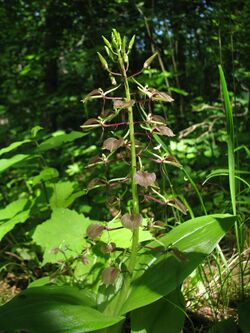Biology:Liparis liliifolia
| Liparis liliifolia | |
|---|---|

| |
| Scientific classification | |
| Kingdom: | Plantae |
| Clade: | Tracheophytes |
| Clade: | Angiosperms |
| Clade: | Monocots |
| Order: | Asparagales |
| Family: | Orchidaceae |
| Subfamily: | Epidendroideae |
| Subtribe: | Malaxidinae |
| Genus: | Liparis |
| Species: | L. liliifolia
|
| Binomial name | |
| Liparis liliifolia (L.) Rich. ex Lindl.
| |
| Synonyms[1] | |
|
List
| |
Liparis liliifolia, known as the brown widelip orchid,[2] lily-leaved twayblade,[3] large twayblade, and mauve sleekwort,[4] is a species of orchid native to eastern Canada and the eastern United States. It can be found in a variety of habitats, such as forests, shrublands, thickets, woodlands, and mountains. The orchid is considered globally secure, but it is considered rare or endangered in many northeastern states.
Description
One of the orchid's common names, lily-leaved twayblade, comes from the plant having two connected basal leaves. The leaves are light green, smooth, oval shaped, and have a partial mid-rib. Its delicate flowers are mauve or purple, arranged on a 4–10-inch (100–250 mm) tall stem in a loose cluster, and total up to 31 flowers.[4][5] The petals and sepals are long, thin, and often droop. Its flowers can be green, but it is a rare occurrence. Each flower has a labellum that is wide, flat, and nearly translucent.[4] The labellum is pale purple and has darker veins.[6] The fruit is smaller than the pedicels. Its seeds can only germinate and grow with a specific mycorrhizal fungus that can be found across its range. It has been debated over decades whether liliifolia should have a single or two consecutive i's, although the correct spelling has now been shown to be liliifolia by botanist Bernard Boivin.[7][8]
Distribution and habitat
It is native to eastern Canada (Quebec and Ontario) and the eastern United States . In the eastern United States, it is found in the Appalachians, Ozarks, the Great Lakes region, and the Ohio and Upper Mississippi Valleys, but not the southern coastal plains. The orchid's habitat is in forests, shrublands, thickets, woodlands, and mountains. The highest altitude that the plant can be found in mountains is 4,200 feet (1,300 m). While the plant is considered globally secure, it is rare or endangered in many northeastern states due to declining populations. It can be commonly found throughout much of its range.[1][4][5][9][10][11][12][13]
Ecology
The plant is pollinated by flies, potentially including the species Pegoplata juvenilis.[4][7] It has been speculated that unspecialized insects have pollinated the orchid.[4][7] The North American Orchid Center has stated that it is possible for insects with either long legs or mouthparts to pollinate its flowers.[4] Threats to the orchid include flooding caused by beavers, swamp habitat being drained, and insecticides that kill the flies which pollinate the plant.[7]
References
- ↑ 1.0 1.1 "Liparis liliifolia". World Checklist of Selected Plant Families (WCSP). Royal Botanic Gardens, Kew. http://wcsp.science.kew.org/qsearch.do?page=quickSearch&plantName=Liparis%2Bliliifolia.
- ↑ "Liparis liliifolia". Natural Resources Conservation Service PLANTS Database. USDA. https://plants.usda.gov/core/profile?symbol=LILI3. Retrieved 22 June 2015.
- ↑ Minnesota Wildflowers
- ↑ 4.0 4.1 4.2 4.3 4.4 4.5 4.6 "Liparis liliifolia". https://goorchids.northamericanorchidcenter.org/species/liparis/liliifolia/.
- ↑ 5.0 5.1 Stupka, Arthur (1965). Wildflowers in Color. Harper & Row. p. 21.
- ↑ Croix, I. F. La (January 1, 2008). The New Encyclopedia of Orchids: 1500 Species in Cultivation. Timber Press. p. 246. ISBN 978-0-88192-876-1. https://books.google.com/books?id=to4rytwGiiwC&pg=PA246.
- ↑ 7.0 7.1 7.2 7.3 "Large Twayblade". https://guides.nynhp.org/large-twayblade/.
- ↑ Mattrick, Christopher (2004). "Liparis liliifolia (L.) L. C. Rich. ex Lindley Lily-leaved twayblade". https://www.nativeplanttrust.org/documents/75/Liparis_liliifolia.pdf.
- ↑ Magrath, Lawrence K. (2002), "Liparis liliifolia", in Flora of North America Editorial Committee, Flora of North America North of Mexico (FNA), 26, New York and Oxford, http://www.efloras.org/florataxon.aspx?flora_id=1&taxon_id=242101748
- ↑ "Liparis liliifolia", County-level distribution map from the North American Plant Atlas (NAPA) (Biota of North America Program (BONAP)), 2014, http://bonap.net/MapGallery/County/Liparis%20liliifolia.png
- ↑ Gleason, H. A. & A.J. Cronquist. 1991. Manual of the Vascular Plants of Northeastern United States and Adjacent Canada (ed. 2) i–910. New York Botanical Garden, Bronx.
- ↑ Godfrey, R. K. & J. W. Wooten. 1979. Aquatic and Wetland Plants of Southeastern United States Monocotyledons 1–712. The University of Georgia Press, Athens.
- ↑ Radford, A. E., H. E. Ahles & C. R. Bell. 1968. Manual of the Vascular Flora of the Carolinas i–lxi, 1–1183. University of North Carolina Press, Chapel Hill.
External links
Wikidata ☰ Q15492395 entry
 |

